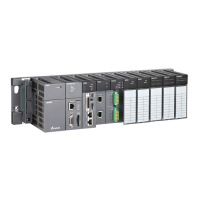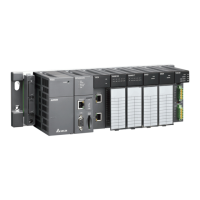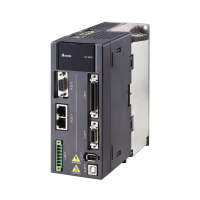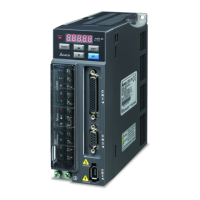Chapter 9 Network Configuration
9-3
9.1.2 Basic Knowledge
Before creating networks, users need to have some basic knowledge. The basic knowledge is introduced in
this section.
Device and network
A device is the most basic element in a network. It is a PLC, a module, or equipment defined by users. A
network is a collection of devices which are interconnected. Every network is assigned a network number.
There are RS-485 networks and Ethernet networks. Besides, a physical interface that a device uses to
connect to a network is a port of the device. If there are more than two ports on a device, the device can
connect to networks which are assigned different network numbers. Please refer to section 9.2.2 for more
information about the marking of a port in NWCONFIG.
PLC name
“AH-01”, “AH-02”, and “AH-03” in the figure above are PLC names. The PLC name of an AH500 series
CPU module depends on the setting in HWCONFIG. Users can identify a device in a network by means
of the PLC name of the device. Please refer to section 8.2.2.1 for more information. However, the PLC
name of a device which is not an AH500 series CPU module is like a comment on the device. It has little
significance.
Node and node number
A node is a basic unit which can operate independently in a network.
~
in the figure above are
nodes.
consists of a CPU module and a network module. The network module can not operate by
itself, and therefore the CPU module and the network module are regarded as one node.
Besides, AH500 series CPU modules can forward packets and perform routing. For example,
in the
figure above can be monitored through
. Before routing is performed, users have to create paths along
which data is sent, and assign node numbers to the nodes which forward the data along the paths. Only
AH500 series CPU modules can be assigned node numbers, and the node number of a node in a
network can not be the same as the node number of another node in the network. After the paths created
are downloaded to the PLCs which forward the data along the paths, every PLC has its own routing table.
The forwarding of the data is directed on the basis of the routing tables produced.
Station address
Users can identify a port in an RS-485 network by means of the station address of the port. The station
address of a port in a network can not be the same as the station address of another port in the network.
Besides, a port is assigned a station address. A port basically represents a station. If a node has several
ports, the ports connected to networks must be assigned station addresses.
IP address and DHCP mode
A port in an Ethernet network is assigned an IP address. The IP address of a port in a network can not be
the same as the IP address of another port in the network, and an IP address can not end with 0 or 255. If
a node has several Ethernet ports, the Ethernet ports connected to an Ethernet network must be
assigned IP addresses.

